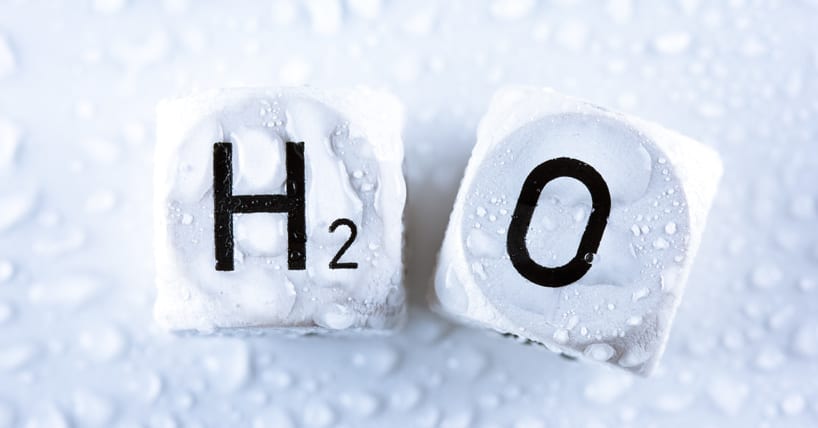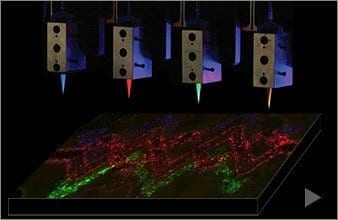Promising cheaper and more efficient way to produce hydrogen.
Generating electricity is not the only way to turn sunlight into energy we can use on demand. The sun can also drive reactions to create chemical fuels, such as hydrogen, that can in turn power cars, trucks and trains.
The trouble with solar fuel production is the cost of producing the sun-capturing semiconductors and the catalysts to generate fuel. The most efficient materials are far too expensive to produce fuel at a price that can compete with gasoline.
“In order to make commercially viable devices for solar fuel production, the material and the processing costs should be reduced significantly while achieving a high solar-to-fuel conversion efficiency,” says Kyoung-Shin Choi, a chemistry professor at the University of Wisconsin-Madison.
In a study published last week in the journal Science, Choi and postdoctoral researcher Tae Woo Kim combined cheap, oxide-based materials to split water into hydrogen and oxygen gases using solar energy with a solar-to-hydrogen conversion efficiency of 1.7 percent, the highest reported for any oxide-based photoelectrode system.
Choi created solar cells from bismuth vanadate using electrodeposition — the same process employed to make gold-plated jewelry or surface-coat car bodies — to boost the compound’s surface area to a remarkable 32 square meters for each gram.
“Without fancy equipment, high temperature or high pressure, we made a nanoporous semiconductor of very tiny particles that have a high surface area,” says Choi, whose work is supported by the National Science Foundation. “More surface area means more contact area with water, and, therefore, more efficient water splitting.”
Bismuth vanadate needs a hand in speeding the reaction that produces fuel, and that’s where the paired catalysts come in.
While there are many research groups working on the development of photoelectric semiconductors, and many working on the development of water-splitting catalysts, according to Choi, the semiconductor-catalyst junction gets relatively little attention.
“The problem is, in the end you have to put them together,” she says. “Even if you have the best semiconductor in the world and the best catalyst in the world, their overall efficiency can be limited by the semiconductor-catalyst interface.”
The Latest on: Hydrogen fuel
[google_news title=”” keyword=”Hydrogen fuel” num_posts=”10″ blurb_length=”0″ show_thumb=”left”]
via Google News
The Latest on: Hydrogen fuel
- ‘The only tailpipe emissions are water’: How do hydrogen cars work?on April 27, 2024 at 11:48 pm
They’re often billed as the next big thing in emissions-free motoring, but how do hydrogen cars work? And how on earth do you refuel them? Hydrogen-powered cars offer an exciting emissions-free ...
- Alberta wants more hydrogen vehicles. Experts say fuel infrastructure needs to come with themon April 27, 2024 at 8:23 am
Experts say building Alberta's hydrogen-fuelled transportation sector means working through a big question: Which comes first, the hydrogen vehicles, or the fuelling stations?
- World’s first hydrogen station for commercial trucks opens – is it too late?on April 27, 2024 at 7:58 am
FirstElement Fuels has opened the world's first large-scale hydrogen fueling station for heavy-duty commercial trucks at Port of Oakland.
- Really Cold Hydrogen Could Bring Driving Range Parity with Dieselon April 26, 2024 at 3:33 pm
The time it takes to fuel a hydrogen-powered fuel cell truck is already on par with diesel. But there is still a yawning gap when it comes to comparable driving range.
- Nikola’s Hydrogen-Truck Fueling Strategyon April 26, 2024 at 11:58 am
Nikola’s Hyla Energy division is using modular hydrogen refueling stations to help bridge the chicken-and-egg gap between supply and demand for fuel-cell-electric trucks.
- California Welcomes First Big-Rig Hydrogen Fuel Station in U.S.on April 26, 2024 at 9:08 am
The country’s first commercial hydrogen fuel station for big-rig trucks is up and running at the Port of Oakland, a step toward what hydrogen proponents see as a clean new future for long-haul ...
- 3 Hydrogen Stocks That Could Be Multibaggers in the Making: April Editionon April 25, 2024 at 3:15 pm
InvestorPlace - Stock Market News, Stock Advice & Trading Tips There are some multibagger hydrogen stocks that investors should have on their ...
- This legendary brand cracks the code: here’s the most powerful hydrogen fuel cellon April 25, 2024 at 7:29 am
Legendary brand has created the first lightweight hydrogen fuel cell: the most powerful, but the smallest ever seen in history ...
- FirstElement brings heavy-duty hydrogen fueling capabilities to the masseson April 25, 2024 at 6:03 am
FirstElement opens the first public hydrogen fueling station for commercial vehicles in the Port of Oakland, helping eliminate almost 50 million lb. of CO2 emissions.
- The first big-rig hydrogen fuel station in the U.S. opens in Californiaon April 24, 2024 at 3:00 am
The Port of Oakland is home to the United States' first commercial hydrogen fuel station for big-rig trucks. It's a step on the road to cleaner trucking.
via Bing News











